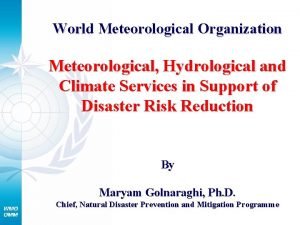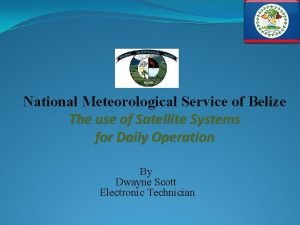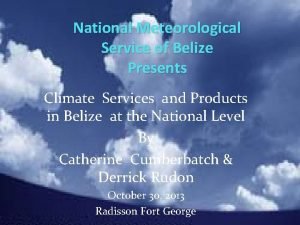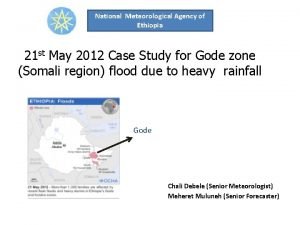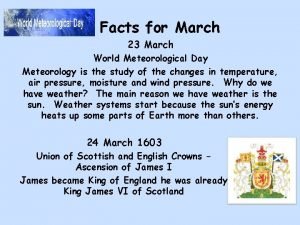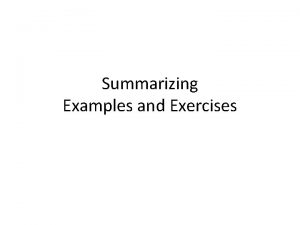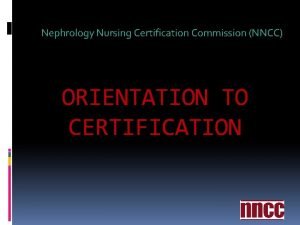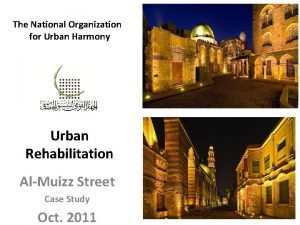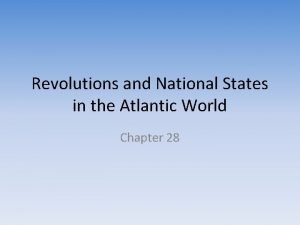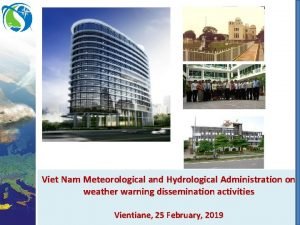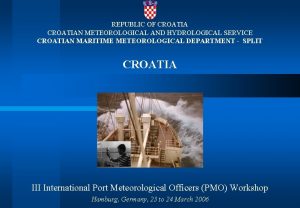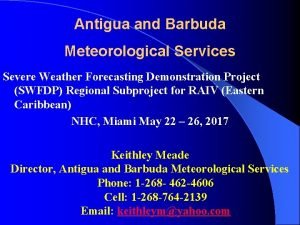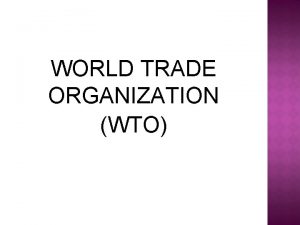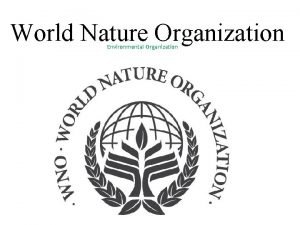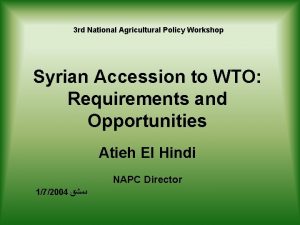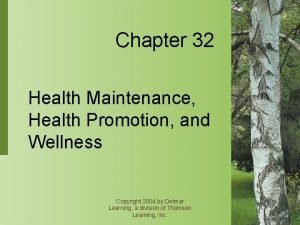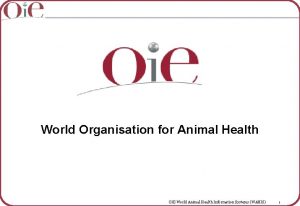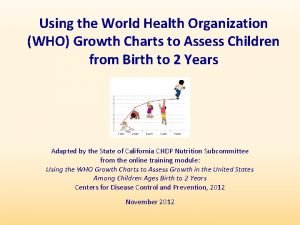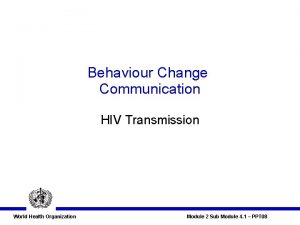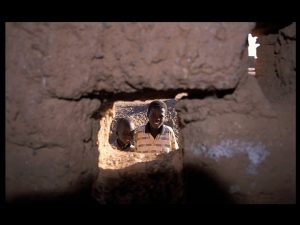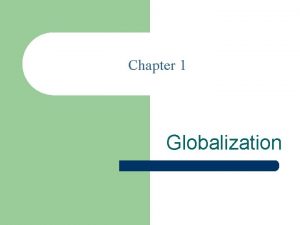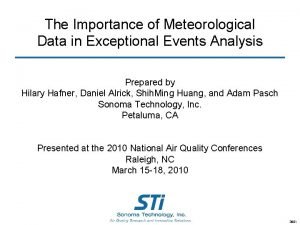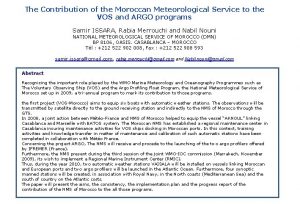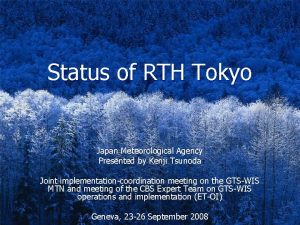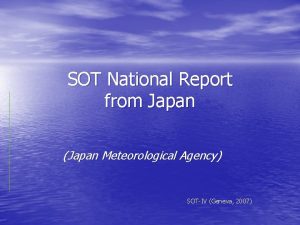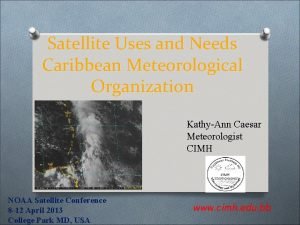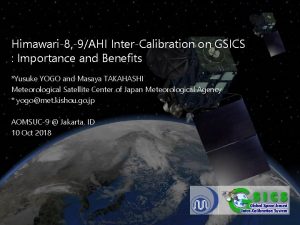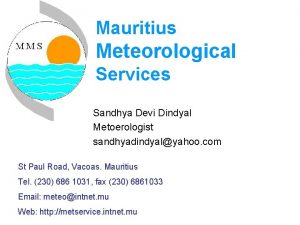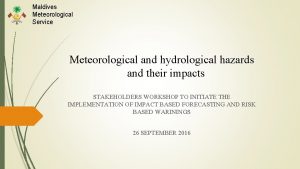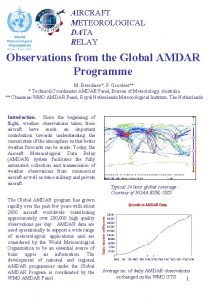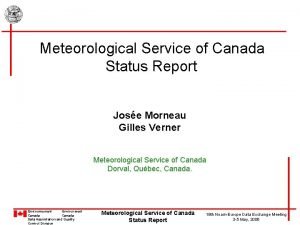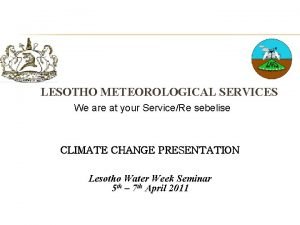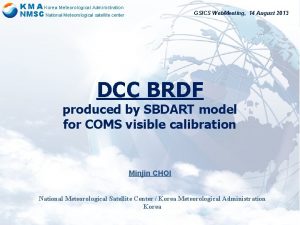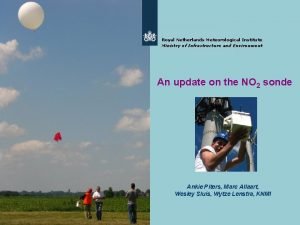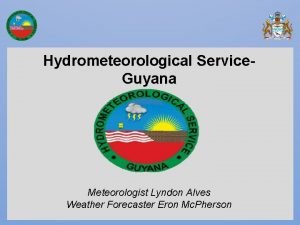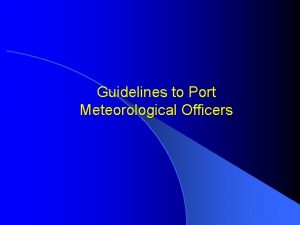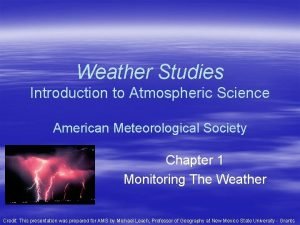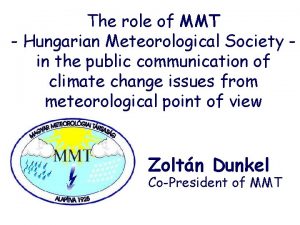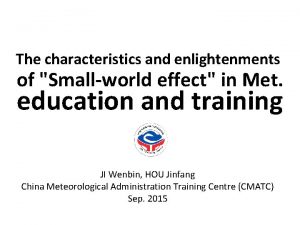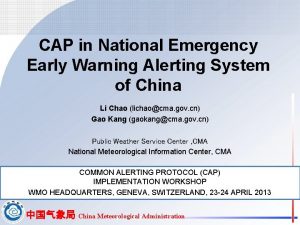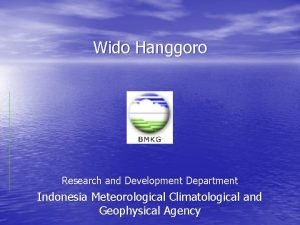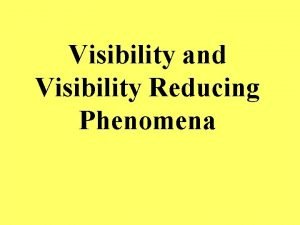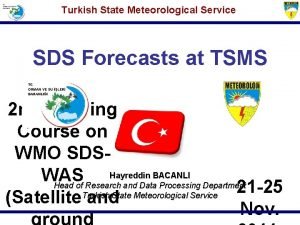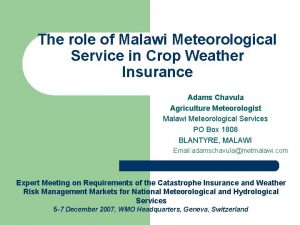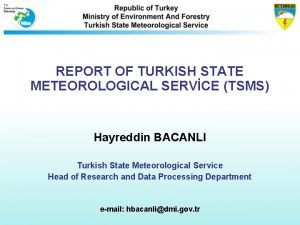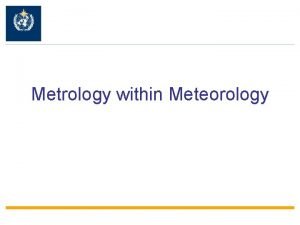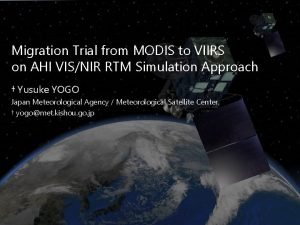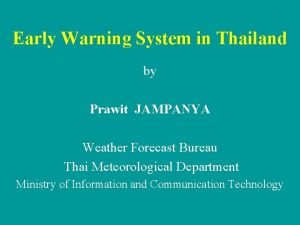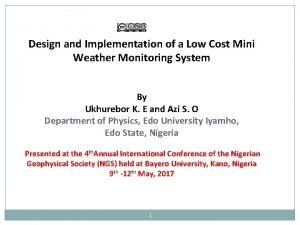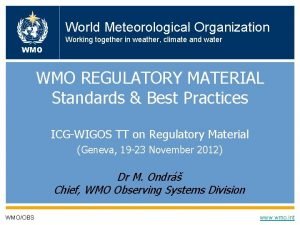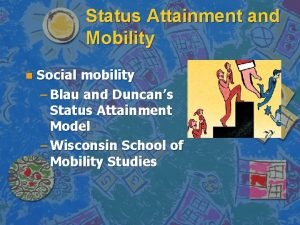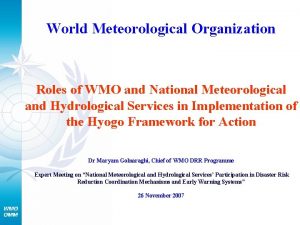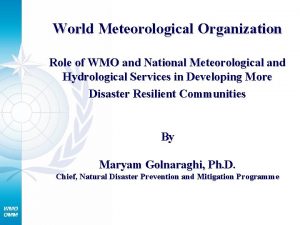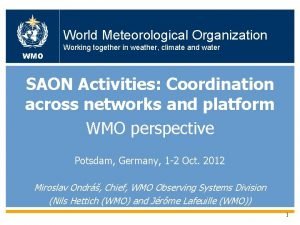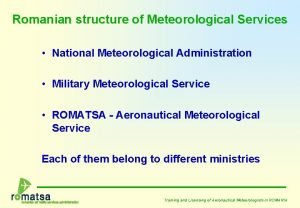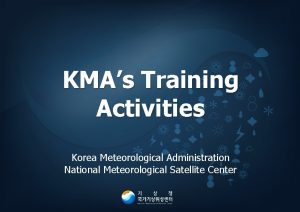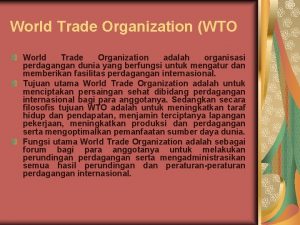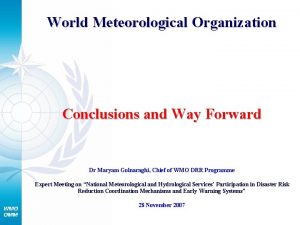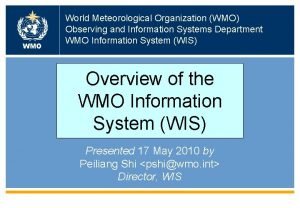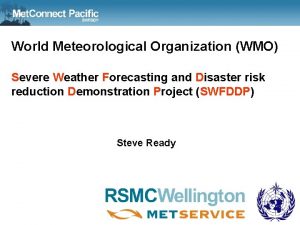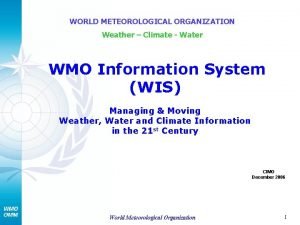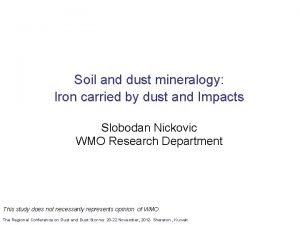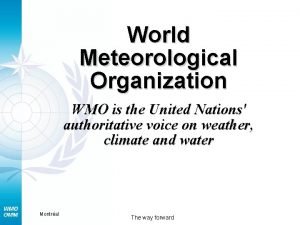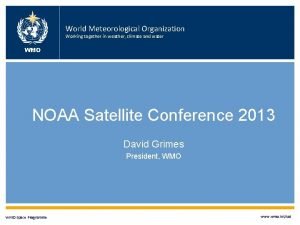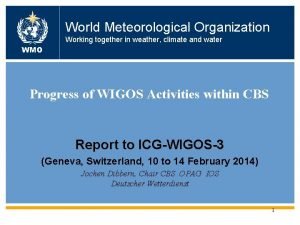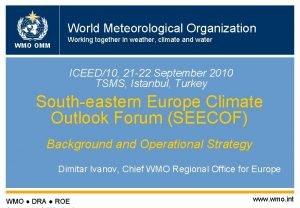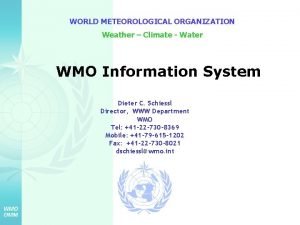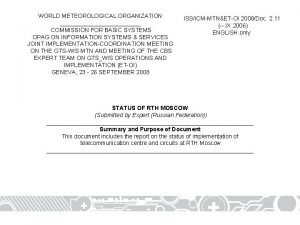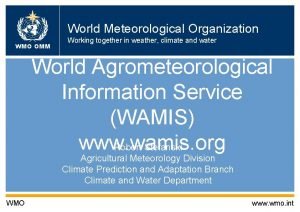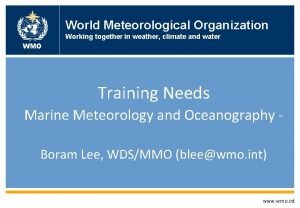World Meteorological Organization Status of National Meteorological and













































































- Slides: 77

World Meteorological Organization Status of National Meteorological and Hydrological Services Capacities in Support of Disaster Risk Reduction in Africa (WMO Regional Association I) (based on WMO DPM Country-level Survey 2006) By ? ? (? )

We cannot avoid hazards

…but we can Prevent Them from Becoming Disasters One Dollar spent on disaster preparedness can prevent 5 - 10 Dollar of disaster-related losses Source: World Resources Institute

Agenda 1. Impacts of Weather-, Water- and Climate. Related Extreme Events in Africa 2. Examples of Benefits of Meteorological, Hydrological and Climate Services to Disaster Risk Reduction 3. Challenges for Reduction of Disasters Related to Weather, Water and Climate 4. How can WMO help?

Impacts of Weather-, Water- and Climate. Related Extreme Events in Africa

Regional Distribution of Natural Disasters (Number of Events, 1980 -2005) Source: EMDAT: The OFDA/CRED International Disaster Database - www. em-dat. net - Université Catholique de Louvain - Brussels - Belgium

Regional Distribution of Natural Disasters (Loss of life, 1980 -2005) Earthquake: 30 000 Heatwave: 50 000 Windstorms: 230 000 Flooding: 40 000 Windstorms: 30 000 Earthquake: 205 000 Tsunami: 60 000 Epidemics/famine: 260 000 Windstorms: 40 000 Landslides: 15 000 Flooding: 45 000 Drought: 500 000 Earthquake: 155 000 Epidemics/famine: 120 000 Tsunami: 170 000 Source: EM-DAT: The OFDA/CRED International Disaster Database - www. em-dat. net - Université Catholique de Louvain - Brussels - Belgium

Regional Distribution of Natural Disasters (Economic Losses in billion USD, 1980 -2005) Flooding: 69 Earthquake: 50 Windstorms: 39 Flooding: 194 Flooding: 8 Windstorms: 30 Windstorms: 90 Earthquake: 10 Drought: 3 Earthquake: 170 Earthquake: 11 Wild Fires: 18 Flooding: 23 Drought: 5 Flooding: 3 Windstorms: 3 Earthquake: 9 Drought: 11 Tsunami: 4 Windstorms: 14 Source: EM-DAT: The OFDA/CRED International Disaster Database - www. em-dat. net - Université Catholique de Louvain - Brussels - Belgium

African Countries Included in the Statistical Analysis • • • • • Algeria Angola Benin Botswana Burkina Faso Burundi Cameroon Cape Verde Central African Republic Chad Comoros Congo Democratic Republic of the Congo Djibouti Egypt Eritrea Ethiopia • • • • • Gabon Gambia Ghana Guinea Bissau Ivory Coast Kenya Lesotho Liberia Libyan Arab Jamahiriya Madagascar Malawi Mali Mauritania Mauritius Morocco Mozambique Namibia • • • • • Nigeria Rwanda Sao Tome and Principe Senegal Seychelles Sierra Leone Somalia South Africa Sudan Swaziland Togo Tunisia Uganda United Republic of Tanzania Zambia Zimbabwe

Distribution of Natural Disasters Events in Africa (1980 -2005) Source: EMDAT: The OFDA/CRED International Disaster Database - www. em-dat. net - Université Catholique de Louvain - Brussels - Belgium More than 95 % of natural disasters are related to Climate or Meteorological / Hydrological hazards.

Impacts of Natural Disasters in Africa (Casualties, 1980 -2005) Source: EMDAT: The OFDA/CRED International Disaster Database - www. em-dat. net - Université Catholique de Louvain - Brussels - Belgium 1984: 550 000 casualties (Ethiopia, Sudan, Mozambique, Chad) Meningitis: 48, 000 Cholera / Diarrhoeal: 46, 000 Nearly 98 % of casualties are related to Climate or Meteorological / Hydrological hazards.

Impacts of Natural Disasters in Africa (Economic losses in USD, 1980 -2005) Algeria: 10 billion USD (1980, 1985, 1987, 1999, 2003) Source: EM-DAT: The OFDA/CRED International Disaster Database - www. em -dat. net - Université Catholique de Louvain Brussels - Belgium 45 % of economic losses are related to Climate or Meteorological / Hydrological hazards.

Reducing / Managing Risks of Disasters

What do we Mean by Risk ? Hazard Risk Intensity Vulnerability HIGHER RISK Vulnerability Frequency

Disaster Risk Management Involves a Wide Range of Decisions and Actions Disaster Risk Management Risk Identification ® Historical hazard data and analysis Changing hazard trends Vulnerability assessment Risk quantification Risk Reduction Sectoral planning Early Warning Systems Emergency Preparedness planning Education and training Risk Transfer Financial tools • Insurance • Weather derivatives • Cat bonds

Need for Partnerships and Coordination Among Different Players Governance, Organizations, Operations Scientific, Technical, Research, Operational Services Sectoral Planning (Hazard Observing & Forecasting, Risk Identification) Financial Civil Protection & Humanitarian (Risk Transfer) (Emergency Preparedness and Response) Media (Communication)

Need for Effective and Harmonized Governance, Institutional and Operational Mechanisms Disaster Risk Management Operational Governance ® Processes and mechanisms ® Strong political will and commitment ® Integration of information in ® Disaster management plans decision process Legislation and policies (all levels) Legal frameworks Organizational ® Preparedness and drills ® Training Effective response Feedback Clarity of roles and responsibilities Coordination and partnerships Integrated planning

Shifting Disaster Risk Management from Reaction to Prevention • Traditionally, disaster risk management approach has been focused on emergency response and recovery measures World Conference on Disaster Reduction (WCDR) 168 countries adopted Hyogo Framework for Action (HFA) Kobe, Japan, January 2005 • Shifting disaster risk management to a more comprehensive approach, involving – – prevention preparedness contingency planning emergency response and recovery measures.

Benefits of Meteorological, Hydrological and Climate Services to Disaster Risk Reduction

National Meteorological and Hydrological Services Provide products and services, 24/7 Ø Meteorological, hydrological, climate and hazard information and mapping Ø Early Detection, Forecasts and Warnings (next hour to climate time scales) Severe storms, tropical cyclones (hurricanes and typhoons), storm surges, floods, cold spells, heat waves, droughts, forest fires, locust swarms, etc…

Disaster/Emergency Management Systems Hazards, Climatic design values Special forecasts; Risk guidance RISK MANAGEMENT CRISES MANAGEMENT Hazards: Emergency Planning Forecasts & Warnings; improved Warning systems

WMO Scientific and international research Programmes - Advancing the knowledge of natural hazards and their changing patterns Northern Atlantic Oscillation La Niña Pacific Decadal Oscillation

World Meteorological Organization 133 years of international and regional cooperation in support of national capacities for meteorological, climate and hydrological services for socioeconomic development

WMO Coordinated Networks in Support of Disaster Risk Reduction: Observation & Communication Coordinated Satellite Activities Global Observing System Global Telecommunication System

Regional Coordinated Networks in Support of Early Warnings, Specialized Services and Training

Return on Investment in Meteorological, Hydrological and Climate Services : 10 to 1 WMO Secretary-General, Madrid, 19 March 2007 Building capacities of National Meteorological and Hydrological Services is an investment toward national development.

Example of Regional Cooperation: WMO Global Tropical Cyclone Early Warning System Regional cooperation (6 Regional Centres) in support of national tropical cyclone early warning systems

Supporting National Capacities for Disaster Risk Management 24 hours a day, everyday of the year, in every country National Meteorological and Hydrological Services Products and Services Needs, requirements, Feedback

Contributions of National Meteorological and Hydrological Services to Risk Identification • Availability of historical and real-time hazard databases • Hazard analysis and mapping methodologies – – Severity , Frequency, Location, Timing Statistical analysis of historical data GIS/GPS mapping Probabilitic climate models – Forward looking trend analysis • Emerging technologies (factors in changing patters due to climate variablity and change)

Contribution of National Meteorological and Hydrological Services to Risk Reduction • Input into sectoral planning (zoning, development, etc) • Early warning systems – Probabilistic forecasting and warnings from next hour to longer climate timescales – Integration of risk information into warning messages – Communication and dissemination – Partnerships, joint planning and joint training with national agencies responsible of emergency preparedness and response • Meteorological Services in support of pre- and post -disaster response and relief operations

Contribution of National Meteorological and Hydrological Services to Risk Transfer products Insurance provider Government Weather derivatives Private sector Catastrophe bonds example – Crop / flood insurance – Agricultural and drought derivatives – Insurance for property and casualty – Micro-insurance – Weather derivatives – Catastrophe bonds for hurricanes

WMO Coordinated Networks in Support of Disaster Risk Reduction: Observation & Communication Coordinated Satellite Activities Global Observing System Global Telecommunication System

WMO Scientific and International Research Programmes - Advancing the Knowledge of Natural Hazards and their Changing Patterns Northern Atlantic Oscillation La Niña Pacific Decadal Oscillation

Objectives ♦ To determine the predictability of climate ♦ To determine the effect of human activities on climate Strategic Framework 05 -15: To facilitate analysis and prediction of Earth system variability & change for use in an increasing range of practical applications of direct relevance, benefit & value to society

WCRP Climate Research In Africa • CLIVAR-VACS: Variability of the African Climate System – African Climate Atlas – WCRP/WCP/START Workshop, Tanzania, July 06 • AMMA: African Monsoon Multidisciplinary Analyses – 2 nd Int. Conference, Germany, Nov. 07

Improve Climate Info Quality & Delivery WCRP JSC-28 in Zanzibar (March 2007): • Tanzania Meteorological Agency (local host) • Build stronger networks especially in Africa • Deliver value to NMHS, sponsors and end users WCRP/WCP/START Workshop for young African scientists, March 28, 2007

IPCC AR 4 • IPCC AR 4 CMIP 3 archive: >1000 users, 200 pubs • WCRP is mainstay of WGI (science) plus input WGII & WGIII • African Climate Atlas, Part VI: To include IPCC AR 4 data Workshops: • GCOS-WCRP-IGBP workshop “Learning from AR 4” (Sydney, Australia, Oct. 07) • WCRP-ICTP Training Seminar: Interpreting Climate Change Simulations: Capacity Building for Developing Nations (Nov. 07)

Climate Predictions for Malaria Palmer et al. , 2006 High malaria WMO Norbert years Gerbier-Mumm Award Prize money being used for malaria project in Tanzania Low malaria years Seasonal prediction workshop: Barcelona June 07 Thompson et al. 2006

Regional Coordinated Networks in Support of Early Warnings, Specialized Services and Training

WMO Mechanisms to Support Members' Scientific and Technical Capacities Thematic 8 Technical Commissions Basic Systems (CBS) Instruments and Methods of Observations (CIMO) Hydrology (CHy) Atmospheric Sciences (CAS) Aeronautical Meteorology (CAe. M) Applications of Meteorology (AMP) Technical Cooperation (TCO) Atmospheric Research and Environment (AREP) World Climate (WCP) Regional (RP) 6 Regional Associations (RA) Oceanography and Marine Meteorology (JCOMM) 10 Programmes Hydrology and Water Resources (HWR) 2 World Meteorological Centres (WMC) Agricultural Meteorology (CAg. M) Climatology (CCl) Education and Training (ETR) Regional Space (WSP) Disaster Prevention and Mitigation (DPM) Members' National Meteorological and Hydrological Services (NMHSs) 40 Regional Specialised Meteorological Centres (RSMC) 30 Regional Meteorological Training Centres (RMTC) World Weather Watch (WWW) PARTNERS

24 hours a day, everyday of the year, in every country National Meteorological and Hydrological Services Hazard analysis, advisory and warning services for a wide range of hazards Feedbacks, needs, requirements

WMO Sustainable Integrated Capacity Development Action Plan in Disaster Risk Reduction Implementation through regional and national projects, including the following elements: 1. Modernization of NMHSs and observing networks. 2. Implementation of national operational multi-hazard early warning systems. 3. Strengthening of hazard analysis and hydrometeorological risk assessment tools. 4. Strengthening NMHSs cooperation with civil protection and disaster risk management agencies. 5. Coordinated training and public outreach programmes.

Components of Effective Early Warning Systems Governance, Organization and Operations Observing, detecting & Forecasting of Hazards “Authoritative” Understandable Warnings & Dissemination Mechanism Risk Identification and Integration in Warning Messages Integration in Emergency Preparedness, and Response

Symposium on Multi-Hazard EWS for Integrated Disaster Management (WMO Headquarters, 23 -24 May 2006) • Issues: Governance, institutional, technical, operational, resource challenges, benefits and synergies, along the four components of EWS • Participants: 99 experts and practitioners from 18 agencies working in different components of early warning system

Challenges for Effective Early Warning Systems Risk Identification • Data gaps, quality, accessibility, sharing – – Hazard Vulnerability (e. g. socio-economic, topographic…) (e. g. hazard analysis, risk modelling) • Understanding of the changing patterns of risk (e. g. hazard, vulnerabilities) • Local capacities Observing, Detecting, Forecasting • Strengthen observation systems coverage sustainability inter-operability multi-use of networks (where practical) built on "system of systems" concept data policies • Prediction and forecasting – – • Effective warning messages: – Incorporation of information about risks in warning messages – Understandable warning messages – “Authoritative” warnings (Authentication of sources) • Standardized methodologies and expertise – – – Communication and Dissemination methodologies, accuracy and lead time multi-disciplinary Coordination and partnerships across components ! • Dissemination networks: – Interoperability (use of international standards) – Redundancy and resilience of networks – Same distribution channels for warnings of different hazards (cost efficiency, reliability and effectiveness) • Standard warning terminologies – Nationwide and across borders – Traffic light concept Emergency Planning, Preparedness and Response • Education and awareness (emergency responders, authorities, risk managers, emergency responders, media, public…): – – – Understanding of warnings and uncertainties Awareness of less frequent events Cross-training of operational agencies and media • Operational planning – – Drills Community preparedness and programmes

Preliminary Analysis of the Response of African Countries to the Survey of Scientific and Technical Capacities in Support of Disaster Risk Reduction

Systematic Assessment of Capacities, Requirements and Priorities in Africa (final report to be published Q 4 2007) At national level: 1. Hazards affecting the countries 2. Role of NMHSs for disaster risk reduction 3. Capacities to deliver products and services in support of disaster risk reduction 4. Challenges, requirements and opportunities At regional level: Global Survey of Scientific and Technical Capacities in Support of Disaster Risk Reduction 1. Regional strategy for disaster risk reduction 2. Opportunities for partnerships

Participation in the Survey 28 African countries contributed to the survey

National Context for Disaster Risk Reduction: Legislation and Governance Disaster reduction activities are coordinated at the national level: 24 / 28 Disaster reduction activities are coordinated under the direct line authority of the head of government: 20 / 28 Legislation governs the way that disaster risk reduction is organized in the countries: 21 / 28

National Context for Disaster Risk Reduction: National Structures/Mechanisms for Disaster Risk Reduction A national committee for disaster risk reduction involves multiple ministries and agencies: 23 / 28 A national legislation clearly defines the roles that each organization or agency plays within this national committee: 15 / 23 NMHS is a member of this national committee: 23 / 23

Number of responding countries who identified themselves as being affected by specific hazards

National Capacities for Issuance of Warnings

Number of Countries Maintaining Standardized Information about Hazards and their Socio-Economic Impacts A national agency is responsible for providing official information on the impacts of disasters in the country: 22 / 28 National Meteorological and Hydrological Services have access to official, reliable, information on impacts: 16 / 28

National Context for Disaster Risk Reduction: Contributions of NMHS to National Disaster Risk Reduction Support provided by NMHSs (through expertise, products and services) to agencies responsible for disaster risk reduction

National Context for Disaster Risk Reduction: Contributions of NMHS to National Disaster Risk Reduction Support provided by NMHSs (through expertise, products and services) to different sectors

National Context for Disaster Risk Reduction: Contributions of NMHS to National Disaster Risk Reduction 24 hours a day, every day of the year forecasting service: 22 / 28 24 hours a day, every day of the year dedicated warning service: 19 / 28

National Context for Disaster Risk Reduction: Contributions of NMHS to National Disaster Risk Reduction NMHS provide early warning information to:

National Context for Disaster Risk Reduction: Contributions of NMHS to National Disaster Risk Reduction Dissemination methods for warnings:

National Context for Disaster Risk Reduction: Limiting Factors for Contributions of NMHSs to DRR Lack of resources and infrastructure to deliver critical products and services for disaster risk reduction: 26 / 28 Lack of linkages between the NMHS and other organizations (e. g. emergency response): 23 / 28 Lack of clear legislation or policies regarding the role of the NMHS: 16 / 28

Common Challenges for Disaster Risk Reduction in Africa Governance: – Demonstrating socio-economic benefits of prevention measures Organizational coordination: – Partnerships, definition of roles and responsibilities of every stakeholders Technical: – Telecommunications, internet access, computer hardware and software – Observing networks development and sustainability – Hazard data: data management, methodologies for data rescue, quality assurance, statistical analysis of hazard characteristics and mapping – Specialised forecasting services in support of risk reduction Education and Training: – Technical training and capacity development – Joint multi-disciplinary training with multiple agencies – Public outreach programmes Capacities are highly variable from country to country

Examples of Ongoing Activities Involving WMO and NMHSs in Support of Disaster Risk Reduction in Africa

Food Security Early Warning Systems for Desert Locusts • Countries in West Africa: Senegal and Mauritania • Partners: FAO, Italian Institute of Biometeorology (IBIMET)

Health Malaria Outbreaks Anticipation • Malaria Outlook Forums (MALOFs): – Utilisation of advanced and improved climate information from the Regional Climate Outlook Forums to anticipate malaria outbreaks • Countries: – Started in 2004 in southern Africa – Extended to Greater Horn of Africa in March 2007 – To be operationalized in Western Africa and all countries in Malaria belt • Partners: – WMO, NMHSs, ACMAD, WHOAfrica, IRI, etc.

Transportation Training and Capacity Building for Safety of Air Navigation • Countries: French speaking African countries • Partner: ASECNA (Agence pour la securité de la navigation aérienne en Afrique et à Madagascar) • Desired Outcomes: Improvement to the safety of air navigation in Africa.

Climate Outlooks and Climate Watch (since 1997) • Outcomes: – Seasonal climate outlooks (July-September) – Early warning of climate extremes – Climate Watch Bulletins • Countries: West African Countries + Cameroon, Chad • Partners: – ACMAD, AGRHYMET, NMHSs, WMO, France, UK, USA, ICRISAT, …

Climate for Development in Africa (‘Clim. Dev Africa’) • Purpose: To mainstream climate information into decision-making for African development • Countries: all African countries • Partners: African Union, African Development Bank, UN Economic Commission for Africa • First Outcome: “Climate Information for Development Needs: An Action Plan for Africa” 18 -21 April 2006 - Addis Ababa, Ethiopia

Climate Adaptation in West Africa • Objectives: Reducing vulnerability of natural and socioeconomic systems to climate change in West Africa • Partners: CILSS, ACMAD, ECOWAS and UNECA • Way forward: September 2007: Action Plan for West Africa

African Monsoon Multidisciplinary Analyses Goals: (AMMA) – Identify relations between Monsoon variability and sectoral issues (e. g. health, water resources, food security, demography) – Utilisation for prediction and decision making Countries in West Africa: All West African Countries Partners: 30 countries & ~140 institutions (Africa, Europe, USA)

Drought Risk Assessment Project (to be initiated in 2007): – Data Assessment and Management – Drought Assessment – Risk Assessment – Training and Capacity Building – Data and Information Delivery Systems

Severe Weather Forecasting Demonstration Projects To improve severe weather forecasting services in countries where sophisticated model outputs are not currently available

THe Observing System Research and Predictability Experiment (THORPEX) To transform timely and accurate weather forecasts into specific and definite information in support of decisions that produce the desired societal and economic outcomes for reducing risks of natural disasters

Other Disaster Risk Reduction Activities Involve National Meteorological and Hydrological Services in Africa Energy Water Resource Management Food security Transport Health Industry

Partnerships are Critical for Reducing Risks of Disasters WMO and NMHSs work closely with the following partners: – World Bank and its Global Facility for Disaster Reduction and Recovery • Modernization of NMHSs to strengthen their contribution to disaster risk reduction – UNDP and Global Risk Identification Programme • Development of standard methodologies for hazard analysis and mapping and risk assessment (drought and flood) – UNESCO and its IOC • Utilisation of the GTS as the backbone for exchange of tsunami-related information – IFRC • Enhancing capacities for community-based early warning systems – OCHA and Inter-Agency Standing Committee • Utilisation of climate outlooks for humanitarian contingency planning – WHO • Linking climate and health (e. g. malaria outlooks) – FAO • Drought and locust monitoring for food security – UNOSAT • Development of high resolution products combining imagery available from the Disasters Charter and meteorological outputs – ISDR System and Global Platform for Disaster Risk Reduction • Development of a framework for integrated work programming among all actors involved in various aspects of disaster risk reduction

WMO can assist with • Cooperation through the network of National Meteorological and Hydrological and Climate Services and Regional Specialised Centres • Expertise in meteorology, hydrology and climate • Project development and management • Coordination of activities and training

WMO and NMHSs Can Participate in Strengthening Disaster Risk Reduction Capacities in Africa Regional Specialised Centres: – Algiers – Cairo – Casablanca – Dakar – Harare Regional Training Centres: – Akure – Cairo – Lagos – La Réunion – Mulemba – Nairobi – Nyamey – Niamey – Pretoria – Oran – Tunis – Tananarive

Conclusions • Loss of life in Africa is highly linked to meteorological and hydrological hazards • Drought and floods account for 30% of economic losses linked to natural hazards in Africa • There is potential increasing risk associated with hydrometeorological disasters linked to climate variability and change, • National Meteorological, Hydrological and Climate Services (NMHSs) provide critical support for prevention and preparedness – Hazard analysis in support of risk assessment and sectoral planning, – Early warning systems • National meteorological, hydrological and climate capacities vary significantly in the region • Investment in NMHSs (human resources, infrastructures, services) is a contribution towards sustainable development. • Regional cooperation and multi-disciplinary partnerships are critical to support national DRR plans. • WMO through national and regional projects involving National Meteorological and Hydrological Services, Regional Specialised Centres and the civil protection authorities is working to strengthen these capacities.

Thank You For more information please contact: Maryam Golnaraghi, Ph. D. Chief of Natural Disaster Prevention and Mitigation Programme World Meteorological Organization Tel. 41. 22. 730. 8006 Fax. 41. 22. 730. 8023 Email. Mgolnaraghi@WMO. int http: //www. wmo. int/disasters
 National meteorological and hydrological services
National meteorological and hydrological services Meteorological service of belize
Meteorological service of belize National met service
National met service National meteorological agency of ethiopia
National meteorological agency of ethiopia March 23 world meteorological day
March 23 world meteorological day Block organization and point by point organization
Block organization and point by point organization Process organization in computer organization
Process organization in computer organization National unification and the national state
National unification and the national state Summarizing exercises
Summarizing exercises Nephrology nursing certification commission
Nephrology nursing certification commission National organization for urban harmony
National organization for urban harmony National association of forensic social workers
National association of forensic social workers Revolutions and national states in the atlantic world
Revolutions and national states in the atlantic world Vietnam meteorological and hydrological administration
Vietnam meteorological and hydrological administration Croatian meteorological and hydrological service founded
Croatian meteorological and hydrological service founded Antigua met office
Antigua met office Function of world trade organization
Function of world trade organization World nature organization
World nature organization Largest sports organization in the world
Largest sports organization in the world Wto functions and objectives
Wto functions and objectives Health promotion world health organization
Health promotion world health organization World animal health information system
World animal health information system World health organization growth charts
World health organization growth charts World health organization
World health organization World health organization photos
World health organization photos World trade organization
World trade organization World trade organization
World trade organization Ap world history chapter 25 africa and the atlantic world
Ap world history chapter 25 africa and the atlantic world The changing world output and world trade picture
The changing world output and world trade picture The changing world output and world trade picture
The changing world output and world trade picture A national policy of avoiding involvement in world affairs
A national policy of avoiding involvement in world affairs Meteorological symbols for four types of fronts
Meteorological symbols for four types of fronts Importance of meteorological data
Importance of meteorological data Morocco meteorological service
Morocco meteorological service Tokyo meteorological agency
Tokyo meteorological agency Bbxx ship
Bbxx ship Ramsdis
Ramsdis Jma msc
Jma msc Mauritius meteorological service
Mauritius meteorological service Tornado in maldives
Tornado in maldives Colored area
Colored area Czech meteorological institute
Czech meteorological institute Imc meteorological conditions
Imc meteorological conditions Aircraft meteorological data relay
Aircraft meteorological data relay Pakistan meteorological department founded
Pakistan meteorological department founded Meteorological service of canada
Meteorological service of canada Lesotho meteorological services
Lesotho meteorological services Korea meteorological administration
Korea meteorological administration Royal netherlands meteorological institute
Royal netherlands meteorological institute Hydromet guyana
Hydromet guyana Port meteorological officer
Port meteorological officer Weather studies introduction to atmospheric science
Weather studies introduction to atmospheric science Hungarian meteorological service
Hungarian meteorological service China meteorological administration
China meteorological administration China meteorological administration
China meteorological administration Indonesia meteorological department
Indonesia meteorological department Meteorological visibility
Meteorological visibility Turkish meteorological service
Turkish meteorological service Meteorological services for insurance
Meteorological services for insurance Turkey meteorological service
Turkey meteorological service Bipm metrology
Bipm metrology Meteorological satellite center of jma
Meteorological satellite center of jma Weather warning thailand
Weather warning thailand Conclusion of meteorological instruments
Conclusion of meteorological instruments Meteoterm
Meteoterm Primates characteristics
Primates characteristics Did pumpkins come from the new world or old world
Did pumpkins come from the new world or old world Real world vs digital world
Real world vs digital world What is world of forms
What is world of forms Dangerous world tour setlist
Dangerous world tour setlist Awarding the world its world
Awarding the world its world Endless night figure of speech
Endless night figure of speech English world 3 unit 9
English world 3 unit 9 Apa yang dimaksud dengan motivasi perjalanan wisata
Apa yang dimaksud dengan motivasi perjalanan wisata Weber class status party
Weber class status party Difference between status report and progress report
Difference between status report and progress report Blau and duncan
Blau and duncan Knowledge brings enlightenment and high status
Knowledge brings enlightenment and high status
